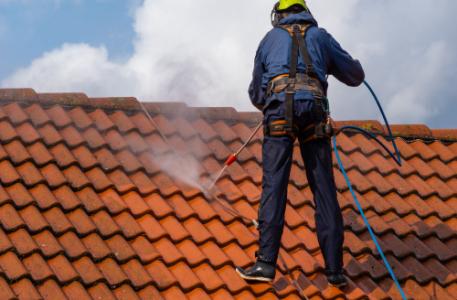
The Pros and Cons of Cleaning Your House with a Power Washer
Your home is a shelter from the elements. But, as a result, its exterior is constantly exposed to wind, dirt, sun, and pollution—plus the stuff that birds, bugs, and other critters leave behind.
Over time, every house needs a good cleaning, and a power washer is often the best tool for the job! Most experts suggest power-washing your home once or twice a year, preferably during the spring and the fall.
It’s an excellent DIY project. However, before diving into this crucial home maintenance chore, consider the pluses and minuses of cleaning your home with a power washer.
PROS
Routine home maintenance.
First and foremost, periodically pressure-washing your home helps preserve its value by keeping your siding, gutters, trim, and doors in tip-top shape. If left unattended for a long time, grime, mold, mildew, moss, algae, and stains can all cause irreparable damage.
While washing each section of the exterior, you’ll also have an opportunity to spot problems that require attention, like missing caulk or loose boards.
Improve curb appeal.
A clean home always looks great, but if you’re getting ready to sell, power-washing your house can instantly boost your home’s appearance and potentially its selling price. It’s one of the easiest ways to banish cobwebs and make your trim sparkle.
And if you need to prime any surfaces for painting, a good cleaning with a pressure washer will improve your final results.
Many applications!
With a power washer, you can clean numerous surfaces outside your home beyond siding and gutters. It’s a terrific way to tackle dirt and grime accumulated on driveways, sidewalks, decks, patios, and retaining walls.
For example, with the help of a grease-busting cleaning solution, a pressure washer can help remove tough oil stains on the floor of your garage or your driveway.
Power washers can quickly tidy up lawn furniture, swing sets, wading pools, and other items with water alone and a light pressure setting.
CONS
Learning curve.
In theory, using a pressure washer is as simple as hooking up a garden hose and turning on the power. First, however, you must decide what type of unit meets your needs and how to use it correctly.
For example, how much pressure do you need? (Gas-powered units tend to be stronger than electric ones.) How high do you need to reach, and what does that imply about hose length and wand extensions? Other considerations include the size of the soap tank and nozzle sizes.
Also, if you don’t think you’ll use a power washer that often—or have limited space to store one—you may decide it’s better to rent one instead. All of these decisions require research.
Potentially dangerous.
If you have a one-story home, pressure-washing your siding and gutters is entirely doable from the ground. But it’s more difficult and risky to clean two-story homes or properties with hard-to-reach features.
Additionally, pressure washers are powerful enough to remove skin or cause blindness. Always wear goggles for protection against water, cleaning solutions, or small bits of dirt and rock that may become dislodged while operating the sprayer.
It might damage your house.
Power washers can tackle the most demanding cleaning jobs. But use caution because it’s also possible to etch permanent lines on some surfaces if the pressure is too intense or the nozzle is too narrow.
Softer siding materials like wood, stucco, and aluminum require a lighter touch and a broader spray than most vinyl siding and brick or stone surfaces. Similarly, wood decks need lower pressures. Also, note that power-washing is not recommended for most fiber cement siding!
With a bit of homework and practice, most homeowners can tackle their power-washing tasks and feel proud of the results! However, if you find the cons outweigh the pros, another option is to hire a professional service.
